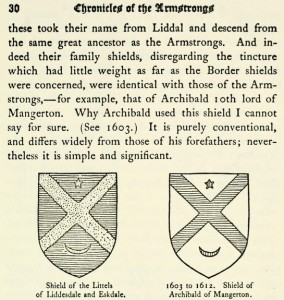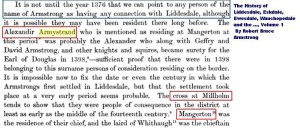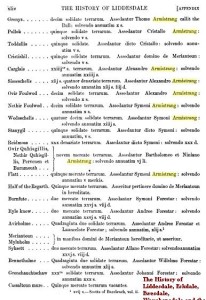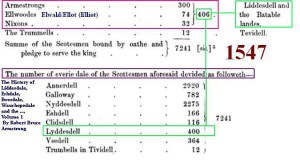Clan Armstrong
Margaret is nicknamed Maggie; for her cleverness and efficiency.
Buck (Buccleuch) is called Buck, because it represents the old location of the estate of Buckcleuch, indicating a Scottish stream bucking through the kraigs.
APPENDIX C The Name
In charters prior to 1500 the name was usually written in Old English ‘Elwald’ or ‘Elwold’. But is was always pronounced ‘Ellot’ (as it often is in the Borders to-day) and by 1600 the phonetic spelling had almost completely superseded all other forms. It therefore appears correct to regard the earlier Saxon form of spelling as archaic an to refer to the clan as ‘Ellots’ until about 1650 when the name was changed altogether to ‘Elliot’.
The introduction of an ‘i’ into the name ‘Ellot’ was, without doubt, unfortunate. It immediately confused the Clan with the well-known English Norman family of St. Germains, settled in the West Country and South Wales and in no way related, whose name was derived from ‘Alyot’. And it confused still further the already indeterminate origin of those whose name was spelt with two ‘Ls’ and two ‘Ts’.
The Elliots; The Storey of a Border Clann
A Genealogical History
by The Dowager Lady Eliott of Stobs and,
Sir Arthur Eliott, 11th Baronet of Stobs
Pub Seeley Service & Co Ltd 1974
Gibert supported the Chief of the Scotts at the rescue of from Carlisle Castle (ca 1597)-Arthur Eliott;
The only serious contention remaining, which is favoured by some modern historians,ascribes the surname to fairly common old Northumbrian christian name of Elwold of Elwald. While convenient in its simplicity, evidence of the Clan’s connection is lacking and, with only two references to Elwald as a surname prior to 1400— in 1230 and 1357 (in Northumberland)– we have no way of testing the validity of this theory.
The Elliots The Story of the Border Clan Arthur Eliott 1986
The history of the emigrations of Border Scots, after the suppression of the clan system in the Borders in the early 1600s, provides some distinct pointers to the distribution of our Clan today and, indeed, give reasonable grounds for supposing that, outside England and Wales, the great majority of those who today call themselves Elliotts ar of Scottish origin.
The Elliots; The Story of a Border Clan,
Arthur Eliott 1986 page 93
October 13 , 2006
A wider view of the history and legend of Castle Hermitage
by Alastair McIntyre of electricscotland.com
Sir Walter Scott of Buccleuch, who was created, in 1606, as first Lord Scott of Buccleuch, from whom descended the Dukes of Buccleuch, holders of the title. The present Duke is the proprietor of Hermitage Castle.
The (Elwald/Ellot) Elliots;
…were called Ae(Æ)lwolds, Elewalds, Elwods, Alwods, Elyards, Helwals, and by many other forms of the name which meant Elk-wood (Anglo-Danish Elgwalt, the name is expressed upon many of their shields). They were ancient neighbors of Mangerton, and sprung, as did the Armstrongs, from Northumbria; they were” mentioned as early as 1165. page 30
,,,many of these people settled (Boece) about Liddesdale, where the Hendersons of Cockburn, the Elwalds of Schaw, (Schaw is just south of the Hermitage Castle but at the time could have meant the land bettween Mangerton and Hermitage) and the Armstrongs had lands, given to them by Malcolm after the battle of Birnam Wood (woods).
The Danes had boasted that they would keep their Yule at York..
The elk-head and antlers stood for the names Elkford or Alford, and Elwald, Elkyard, or Elliot; the latter name originally meant Elk of the Forest. It should be noted the Elwood out of York use a Coat of Arms with an elk-head and antlers in the base.
Chronicles of the Armstrongs; (1902) James Lewis A. excerpts rf Elwald;
It should be noted that the Danish word for elk is elg, and the American word for elk is moose. Basically the word elk means; a deer as big as a horse. The Danish word for bear/bourn is bjørn.
Hope that Clan Armstrong can recognize the quality of genealogical research done by the Arthur Eliott family is of the highest of standards, and helps to support the high quality research as done by James Lewis Armstrong. If Clan Armstrong could give recognition to the work Maggie’s father and grandmother did in the area of Elliot family history it would be greatly appreciated.
Another family which has an archive to this his is that of Buccleuch. Arthur Francis Eliott utilized a lot of information by George Francis Scott Elliot, who likely had access to the Scott family.
Trying to bring the two families together one of Horseleyhill-Redheugh, and the other of Horseleyhill-Gorrenberry together seems impossible, when one received land of the borders and the other was banished from both kingdoms in 1607, and went to the Plantation of Ulster. It is difficult for me especially when the Gilbert family along with Roxburghe; Ker of Cessford, and Clan Kerr chief wants to put a wind farm on Gorrenberry ancestral land. Because of this non recognition, and likely descended of the original, search online; Cowie of Gorrenberry, and you will find me. It should be noted the Scot/Ker feud is still thriving and could bring corporate industrial destruction of all border historical antiquities. It is written though not true by the Buccleuch family that Gilbert killed the head of Cessford. Redheugh, Cessford; Roxburghe, and Clan Kerr are link through Northern British Windpower (NBW) which has beaten Northumberland a relative of Buccleuch in a lawsuit over a wind farm just across the border into Scotland. The borderlands are basically from York to Edinburgh, old Danish Northumbria.
Mark Elliott

It is felt that the name Little is derived by the locality which is the Liddel Water which families like the of Eric Liddel which ran in the 1924 Olympics is from. Also given a the evolution of the name of Alexandir Armystrand of Mangerton 1376, where Armystrand means army, strand (along a bank), and the peel towers of the Armystrand were along a bank;
Then they were referred to as the strong army Armistrang/ army strong or strong army;
As can be seen in the numbers;
Because the Armstrong have a strong arm on their shield add to the Milnholme Cross in the later part of the nineteenth century, it is felt they call themselves which is quite common; the Elwald had an elwand on their sheild and they where sometimes called Elwand, so with a strong arm on the shield the Armstrongs were called Armstrong.
Shield ca 1880added on top of Milnholm Cross shows strong arms. It is likely then as The Chronicles say they are named after what is on there shield Armstrongs. Though some may have already much earlier been using the name the transference from army strand to strong army to strong arm along the Liddel with the Liddell/Little)is where the main surname Armstrong had it’s origins and surname adoption from only the use of personal names, with who’s your father, where one may live, who you sided with or followed the color or you hair and so on if more individualization was needed.
As one can see the strong arms on the shield on top of the Milnholm (IHS) christian Cross.
Mark Elliott 1/1/2015








